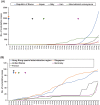Global epidemiology of coronavirus disease 2019 (COVID-19): disease incidence, daily cumulative index, mortality, and their association with country healthcare resources and economic status
- PMID: 32199877
- PMCID: PMC7156123
- DOI: 10.1016/j.ijantimicag.2020.105946
Global epidemiology of coronavirus disease 2019 (COVID-19): disease incidence, daily cumulative index, mortality, and their association with country healthcare resources and economic status
Abstract
It has been 2 months since the first case of coronavirus disease 2019 (COVID-19) was reported in Wuhan, China. So far, COVID-19 has affected 85 403 patients in 57 countries/territories and has caused 2924 deaths in 9 countries. However, epidemiological data differ between countries. Although China had higher morbidity and mortality than other sites, the number of new daily cases in China has been lower than outside of China since 26 February 2020. The incidence ranged from 61.44 per 1 000 000 people in the Republic of Korea to 0.0002 per 1 000 000 people in India. The daily cumulative index (DCI) of COVID-19 (cumulative cases/no. of days between the first reported case and 29 February 2020) was greatest in China (1320.85), followed by the Republic of Korea (78.78), Iran (43.11) and Italy (30.62). However, the DCIs in other countries/territories were <10 per day. Several effective measures including restricting travel from China, controlling the distribution of masks, extensive investigation of COVID-19 spread, and once-daily press conferences by the government to inform and educate people were aggressively conducted in Taiwan. This is probably the reason why there was only 39 cases (as of 29 February 2020) with a DCI of 1 case per day in Taiwan, which is much lower than that of nearby countries such as the Republic of Korea and Japan. In addition, the incidence and mortality were correlated with the DCI. However, further study and continued monitoring are needed to better understand the underlying mechanism of COVID-19.
Keywords: COVID-19; Coronavirus disease 2019; Country healthcare resources; Daily cumulative index; Disease incidence; Mortality.
Copyright © 2020 The Authors. Published by Elsevier B.V. All rights reserved.
Figures





References
-
- World Health Organization (WHO) WHO; Geneva, Switzerland: 2020. Coronavirus disease 2019 (COVD-19). Situation report – 40.https://www.who.int/docs/default-source/coronaviruse/situation-reports/2... Data as reported by 10AM CET 29 February 2020. [accessed 17 March 2020]
-
- Lai C.C., Liu Y.H., Wang C.Y., Wang Y.H., Hsueh S.C., Yen M.Y. Asymptomatic carrier state, acute respiratory disease, and pneumonia due to severe acute respiratory syndrome coronavirus 2 (SARS-CoV-2): facts and myths. J Microbiol Immunol Infect. 2020 March 4 doi: 10.1016/j.jmii.2020.02.012. - DOI - PMC - PubMed
-
- Wu Z., McGoogan J.M. Characteristics of and important lessons from the coronavirus disease 2019 (COVID-19) outbreak in China. Summary of a report of 72 314 cases from the Chinese Center for Disease Control and Prevention. JAMA. 2020 Feb 24 doi: 10.1001/jama.2020.2648. [Epub ahead of print] - DOI - PubMed
MeSH terms
LinkOut - more resources
Full Text Sources

